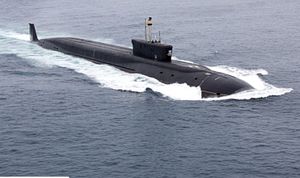The director general of the St. Petersburg-based Rubin Central Design Bureau for Marine Engineering, Igor Vilnit, told Russian state media that there are currently no plans to build the sixth and seven Project 955A Borei II-class (“North Wind”) or Dolgorukiy-class nuclear-powered ballistic missile submarines (SSBN).
Instead Russian submarine construction will focus on more advanced projects that appear to go beyond the two existing SSBN (Borei and Borei A) designs. While Vilnit did not elaborate on the new submarine type, his comments could indicate that Russia is still considering fielding an upgraded Borei-class SSBN variant, designated Borei B-class (or Borei III).
According to a Russian defense industry source, plans to build Borei B-class boomers were scrapped last year. While an earlier draft of Russia’s state armament program for 2018-2027 included funding provisions for the construction of four new Borei B-class subs, an updated version dropped any reference to the SSBNs.
Instead, the Russian Ministry of Defense (MoD) reportedly wanted to build two additional Borei II-class SSBNs with an option for three more. The 2018-2027 state armament program contained reference to two yet to be named Borei II-class SSBNs to be delivered to the Russian Navy in 2026 and 2027, according to a separate defense industry source.
“After the analysis of proposals on building Borei-B nuclear-powered submarines, a decision was made to give them up as the project of building these subs does not meet the ‘cost/efficiency’ criterion. Instead, the final version of the state armament program through 2027 includes Borei-A [Borei II-class] submarines,” a Russian defense industry source told TASS news agency last May.
“The construction of the new series of Project 955A submarines will begin at the Sevmash Shipyard after 2023,” the source added. “Overall, there are plans to build six Borei-A subs, which will be operational in the Northern and Pacific Fleets. With the completion of this series, the Navy will operate 14 new strategic nuclear-powered submarines: 11 Borei-A-and three Borei-class subs.”
Notably, the Russian MoD to date did not publicly confirm the source’s claims regarding the Borei-B class and future submarine construction plans.
Russian MoD and defense industry officials purportedly had repeatedly expressed their discontent with the Borei B design work done by Rubin. Vilinit’s recent comments could indicate that the MoD has finally greenlit the sub’s design. The upgraded Borei-class SSBN reportedly features a new water jet propulsion system, an upgraded hull, and new noise reduction technology, next to a host of other improvements.
The Russian Navy currently deploys three Borei-class SSBNs. The Yuri Dolgoruky is in service with Russia’s Northern Fleet, while the remaining two Borei-class SSBNs – Alexander Nevsky and Vladimir Monomakh — are deployed with the Russian Pacific Fleet.
The Russian Navy is slated to take delivery of the Knyaz Vladimir, the first Project 955A Borei II-class boomer, later this year. The submarine will be delivered two years late as a result of a contract dispute between the Russian MoD and the Severodvinsk-based Sevmash Shipyards.
Russia is allegedly also working on a new class of nuclear-powered fifth-generation submarines with the first boat expected to be delivered to the Russian Navy by 2027.The work is spearheaded by the St. Petersburg-based Malakhit Design Bureau.
“The Husky-class will reportedly come in three variants: a nuclear-powered attack submarine (SSN), a nuclear-powered cruise missile submarine (SSGN), and a[n] [SSBN],” I wrote last year. “All three variants are expected to share a common two-hull design as well as common sonar, power and propulsion systems.”































